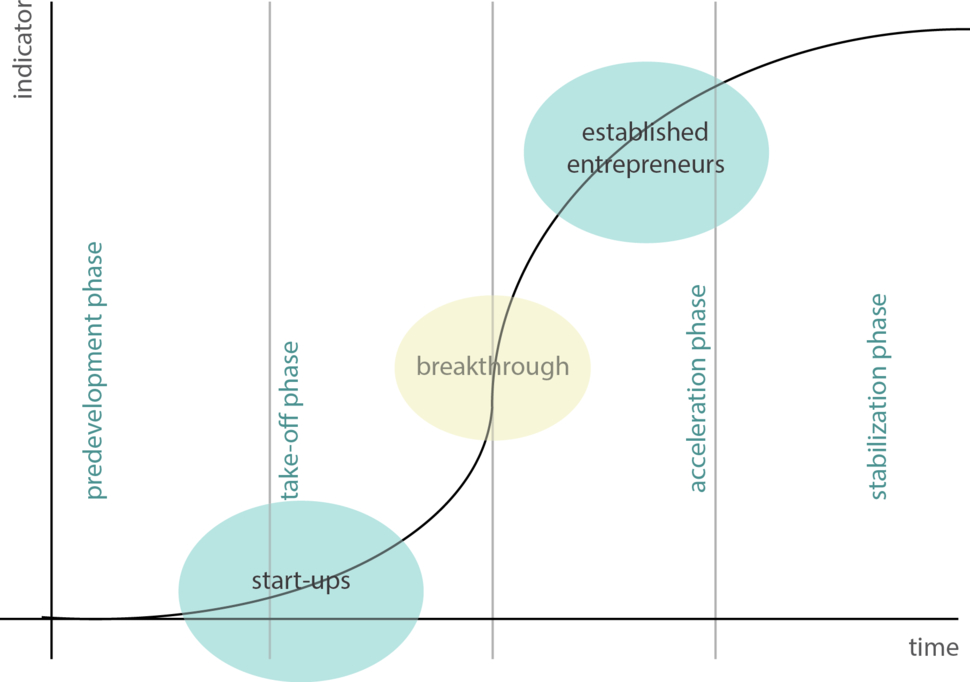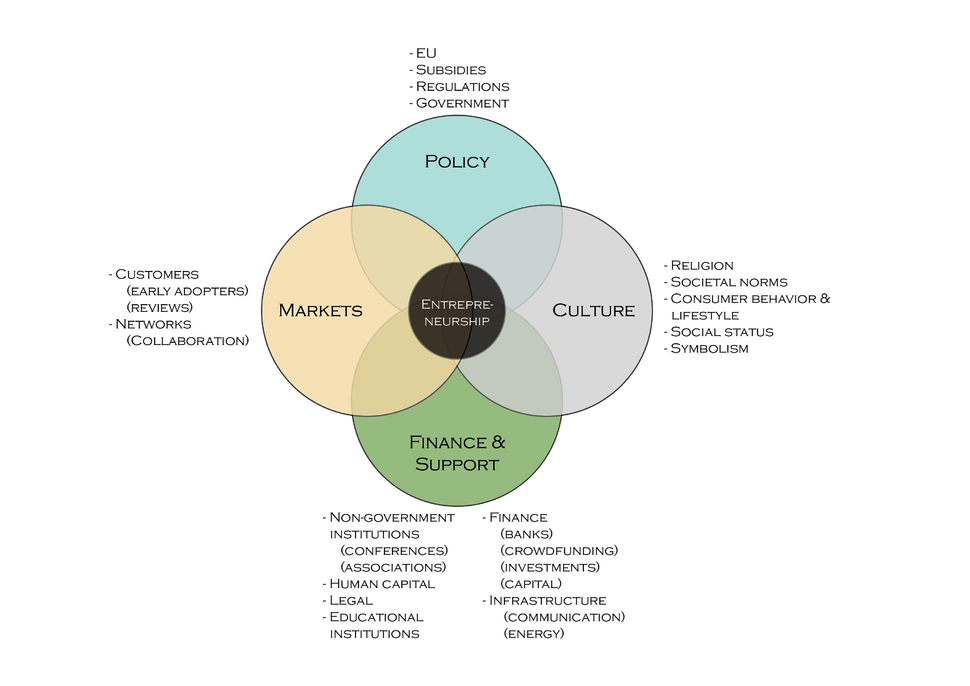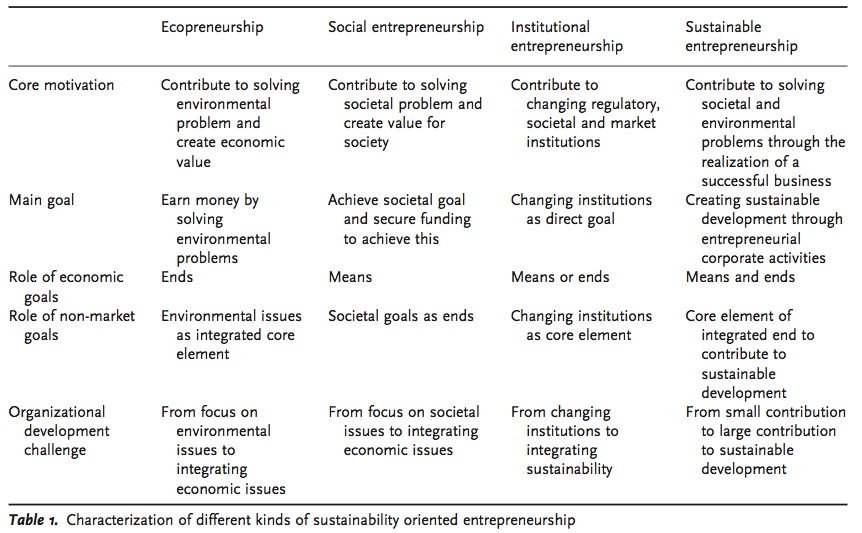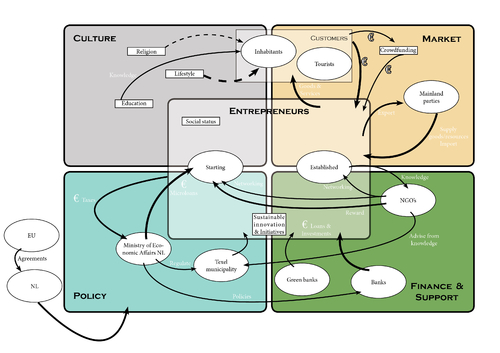A system or sub-system may be seen as closed-loop chain with well-defined boundaries, interrelations and actors. A sub-system per se could be for example waste, transport, water, food, etc; with taking into account that various systems tend to overlap with each other.
Entrepreneurs function as key actors in many of such sub-systems. However, entrepreneurship itself operates within its own sub-system, consisting of government programs and/or services that aim to promote entrepreneurship, resources such as business incubators, entrepreneurship education and training and financing (loans, grants, etc.). Entrepreneurship could be seen as a process of starting a business (typically a so-called startup company), which offers products or services that are based on a perceived gap in the existing market. However, entrepreneurs are also present in already established business, running successfully for a long time. Each of the different types of entrepreneurs face different challenges in their daily life and needs to be approached differently with respect to changing their business.
MLP and entrepreneurship
Within the MLP framework, entrepreneurs can be found in two places. Firstly, in established regimes (these are established businesses or new businesses that do not excel in novel ideas, such as opening a new clothing shop). Secondly, in the niche level. These are generally startups with bright, novel ideas that try to find a spot in the market, eventually trying to break through existing regimes. In order for the entrepreneurs (niches) to “breakthrough” into the regime, usually external financial help is needed.
S-curve and entrepreneurship

Proposed framework for entrepreneurship as a sub system in Texel
When we look at the theory described above, we believe that entrepreneurs will play a key role in achieving the 100% self-sufficiency goal for 2065 on Texel. Since entrepreneurs are generally quite apt in finding gaps in the market and acting upon them, they will be especially useful to promote new innovations and ideas and to help guiding these among the S-curve as described above. Entrepreneurs see opportunities where others don’t, and with the right mindset they can support new technologies, products and services that will benefit Texel.
Whether an entrepreneur decides to set up shop within an established regime or within a niche market, there are several factors that need to be taken into account. After doing some research, we have found a suitable framework, devised by Daniel Isenberg (2011) that we think aptly describes entrepreneurship as a system. However, we decided to simplify this original framework a bit so as to make it more generally understandable for our readers.
Our framework is based on four equally important domains that, even though they each are separate, have an overlap in which entrepreneurship is the key aspect. Elements in each domain can either reinforce or hamper entrepreneurship as a whole and they interact on different levels. Figure 1.6 shows an overview of the domains and how they interact. We will describe each of them shortly.
The Policy domain
As the name already infers, the Policy domain encompasses anything related to policy and regulation, either by government institutions or companies. It is important to notice that policies are not the same as rules or laws: while laws can either compel or prohibit behaviors (for example, you are lawfully obliged not to hurt anybody), policy merely guides actions, aiming them towards achieving a desired outcome. Policies can be fiscal, for example granting tax benefits for certain behavior or by providing R&D subsidy to promote new sustainable technologies. Or they can be functional, for example by demanding transparency (to a certain level) from companies in order to keep competition healthy.
Texel is part of The Netherlands, which in turn is part of Europe. With that in mind, obviously international and national policies apply to Texel as well. However, local policies and regulations are set by the municipality of Texel and can differ from other municipalities or regions. With regards to national policies, in order to stimulate sustainable entrepreneurship the Dutch government has introduced the “transparency benchmark”, stimulating companies to create transparent social reports about their business, and handing out a yearly prize to the company that is most transparent about the economic, environmental and social results of its business operations (Rijksoverheid, 2016). Furthermore, a variety of financial policies are in place to help startups finance their business, such as microloans, “innovatiefonds MKB+”, and certain tax exemptions for entrepreneurs (RVO, 2016)
The Markets domain
The Markets domain involves anything related to economic activity. Consumers and their preferences and economic behavior are part of this, but also how entrepreneurs and consumers interact with each other. Texel entrepreneurs not only deal with local customers. Especially entrepreneurs in the tourism sector will deal with people from outside Texel, even outside The Netherlands. Texel entrepreneurs will have to find gaps in the market just like any other entrepreneur. These can be sold locally or more broadly, for example by smart branding of Texel products. TexelWool is a good example of such branding that has reached big success. Quality blankets, pillows and mattresses from this now well-known brand, all made in Texel, made of wool from Texel sheep, are available throughout The Netherlands and Belgium, and even in Germany and France.
The Finance & Support domain
The Finance & Support domain consists of many things that are vital to entrepreneurs, and that play a supportive role that is required for them to function and to run their business. Think about infrastructures, which exists in many forms. For example: (tele-)communication, energy, product transport & logistics. Non-government institutions can create value for entrepreneurs by creating knowledge sharing platforms. Examples of this for Texel are TOP Texel and JONT.
The finance part is mainly about means to create financial capital, in order to fund startup businesses. The most common forms of capital investment is through bank loans, micro loans, investments from friends or family or so-called “angel investors” which are individuals with capital who take interest in a certain company and decide to invest. Entrepreneurs in Texel will have to deal with finding startup finance just as much as other entrepreneurs.
The Culture domain
Finally, the Culture domain describes mainly social factors that influence entrepreneurship. Examples are religion, lifestyles and daily life behavior. Factors like local societal norms play an important role on how people make choices and how they behave in networks. With “people” in this case we refer to entrepreneurs as well as the consumers or customers that they are trying to reach. With regards to entrepreneurs, the “entrepreneur culture” can be seen as a mindset for entrepreneurship. How entrepreneurs deal with setbacks and failure, how it shapes their (perceived) social status. These entrepreneurial traits make them good intermediators for a successful transition towards self-sustenance in 2065.
In Texel, people have a very tight community and exhibit a sense of pride for their island. Local entrepreneurs often share this pride within their products, TexelWool again being a good example.
Entrepreneurship at the center of the domains
Evidently, these four domains can not be seen as separate entities. For example: the cultural background of a consumer, such as their personal religion, has an important influence on their economic behavior; people with a very non-materialistic mindset will not often buy big flat TV’s. In short, one domain cannot exist without the other, and a successful entrepreneur thus utilizes and combines factors and assets from all domains in order to sustain their business and to find new gaps in the market to fill.
Concluding, the entrepreneur system is a highly interrelated system that covers many aspects. Not only do the domains within this system overlap and interact, the entrepreneur system is also overlapping with many different sub-system that are also part of our complete group research about Texel.
What is sustainable entrepreneurship?
According to the literature there have been several streams of sustainable development in regard of entrepreneurship. Eco-Entrepreneurship deals exclusively with environmentally oriented entrepreneurship, social entrepreneurship is concerned with achieving societal goals and securing its funding, institutional entrepreneurship trying to change institutional settings and last sustainable entrepreneurship addresses the contribution to sustainable development of not only the organization but to society as whole. (Schaltegger & Wagner, 2010). All these 4 types of entrepreneurship are summarized in Table 1:
A sustainable entrepreneur integrates in its business the social and environmental challenges that humans face; we may also call it green market. Sustainable entrepreneurism captures not only financial value, but also environmental and social value (Pascual et al, 2011). In its essence it is the realization of sustainability innovations aimed at the mass market and benefit to the larger part of the society (Schaltegger & Wagner, 2010). The way it is done is again very much dependant on the nature of the business itself. A sustainable entrepreneur should bear in mind the overarching triptych of Elkington’s People-Planet-Profit, as an important driver of any entrepreneur and his business is not the environmental or social consciousness, but the business' profit. As this approach seems rather obvious, in practise the availability budget is generally the starting point in the selection of sustainable measures, sustainability objectives then easily disappear from sight (van Hal, 2014). But by enhancing the sustainable approaches, even a small business may stress its corporate social responsibility, which should generally bring in the long-term economic interest of the business (Smith, 2013). The corporate social responsibility amongst small and medium enterprises, which are present in Texel, is often characterised in the literature as unstructured, informal and ad hoc philanthropic activities. Moreover it faces obstacles as lack of sufficient influence or resources to adequately address social issues or the need to focus on the main business (Amaeshi et al., 2015). Therefore, if the entrepreneurs shall be convinced about the importance of the sustainability, the linkage with the impact on their business must be established.
In today's market the issue of sustainability is mostly used as a “marketing tool”. The term is resonating and thus attractive for not only customers but also investors. Sometimes the marketing is using the ignorance of people regarding sustainability and a business claiming itself to be sustainable might not be entirely sustainable when looking in a closer perspective. As the young people and upcoming generations are however more and more educated and knowledgeable in the issue and importance of sustainability, as customers they will become more aware and demanding. This may help speeding up the process towards sustainable future (Trubat Ponti, 2015).
Consumers are the most important part of the equation while discussing the sustainable entrepreneurship. Most consumers have 4 goals while looking for good (Pascual et. al, 2011):
- price
- comfort
- functionality
- intangible value
Price is what needs to be paid for the product, comfort explains how the product makes the life easier, functionality describes features of the product and “intangible value” is in other words what does the product say about the person purchasing it. Different customers also put different level of importance to each of these determinants. Sustainability is important for the customer only if it is linked to one of the categories; the process of changing the consumer's beliefs in choosing pro-environmental products is a long and expensive journey. Moreover, the products must retain its functionality even when made sustainable, otherwise the sustainability will never be chosen by the customers (Pascual et. al, 2011).
Sustainable business solutions aim to solve social and environmental problems by applying business principles, and as such these are characterized as (Pascual et. al, 2011):
- solutions for one specific social and/or environmental problem: this could be quantified in many metrics depending on the service or product (number of people, energy consumption, CO2 reduction, etc.); such may provide an estimation of the contribution of the solution to solving the problem. Using simple units of measurement is recommended in order to make it understandable for large amounts of people.
- clearly defined business models: the model addresses questions of how to introduce a solution to the market, how to transform the solution into financial return while attaining the sustainability objectives (social and environmental value)
- scalable: as start-ups want to create impact, scalability (ability to implement growth) is crucial. Regarding sustainability the scalability is not only in the expansion to other areas, but also relevance to variety of contexts and markets.
- inspire others to contribute or trigger action among others to develop their own solutions: sustainable solutions welcome competition in contrast to traditional protectionist model. The free use of intellectual property models may play an important role in this regard.
Texel current entrepreneurial sub-system: entrepreneurs & platforms
Looking at the Texel and the entrepreneurship sub-system, we may differentiate several markets in which the drivers for the change towards the sustainable future will differ. While focusing on the sub-system we must thus bear in mind these differences and try to overlook the whole spectrum of possible markets; using the different markets as examples of the applications of our designed strategies. Within these markets we differentiate several types of customers, the other side of the coin; these are residents of Texel, Texel tourists and mainland (residents, companies). There are different interrelations established among these various actors within specific markets, focused on the particular groups.
Within the entrepreneurs themselves we see two specific groups with specific characteristics and starting points: the starting entrepreneurs and the already established entrepreneurs. The starting entrepreneurs are the ones with innovative ideas, searching for a (mostly financial) help to kick their business; these are typical examples of niches. Such startups are very much dependant on the financial support, which can come from several sources: from the European Union or the national government of the Netherlands through certain funding, from the municipality or some big corporations through subsidies or through banks by loans. Focusing on the transition into sustainable entrepreneurship with this group, it is necessary to implement the sustainable ideas already from the start; moreover as the climate change and the subsequent economy transition opens a lot of possibilities for the new initiatives. However, one must bear in mind the difference between young entrepreneurs on one side, creative or even “naive” and already educated in a way of sustainable thinking and starting entrepreneurs on the other side , who are older and may look at the problem of starting business more from a business-like perspective, the financial feasibility.
The other group consists of already established entrepreneurs on the island. These are the ones with already established and profiting business, whose aim might be to increase the business, but also just to keep it as such. These people may be forced to change their business (only) under the external pressure, changing of the market structure, change in demand of customers of if their business is stagnating and they want to make a new kick start. The approach towards this group of entrepreneurs should be thus different in our design strategy.
Several platforms exist on which entrepreneurs from Texel are brought together. TOP-Texel is one of those platforms for entrepreneurs and is divided in ten sections each with their own management. Each sections’ chairman, ten in total, form the board of directors and this board is completed with the chairmen of the Royal Institute of Hotel and Catering Industry the Netherlands (department Texel) and a representative of JONT, the platform for youth entrepreneurs. Top-Texel has very close connections with MKB Nederland, so they can keep their members properly informed about all national developments. MKB Nederland supports small scale entrepreneurs across the Netherlands and their mission is to create and maintain a rosaceous climate for entrepreneurs (MKB Nederland, 2015). They are also in communication with LTO Noord afdeling Texel, which represents the agriculture section of entrepreneurism.
The main task of TOP-Texel is the representation of interests of its clients. By board meetings, current developments can be monitored and discussed amongst the chairmen. Together with all its members, TOP-Texel can function as a collaborate mind to solve problems which affect a bigger group of members within its organisation. They also advise local municipality about their vision and policies. The communities within TOP-Texel are a great way to give individual entrepreneurs a platform on which they can exert influence on behalf of a bigger group of entrepreneurs (TOP-Texel, 2015). In chapter 1.4, we’ll describe what group of entrepreneurs are represented by TOP-Texel and how these ten sections are represented in terms of percentage.
A very important group of entrepreneurs are not addressed within TOP-Texel though. Since the agriculture entrepreneurism is such a big and specific section for the island of Texel, they are represented by their own institution called LTO Noord afdeling Texel, as mentioned earlier in this chapter. They communicate with TOP-Texel a lot, since agriculture and tourism interfere on a lot of occasions. For example, many entrepreneurs in agriculture are active in the tourist industry and therefore have mutual gains in both sectors.
LTO Noord is representing the provinces above the Maas river regarding agriculture entrepreneurism and their main goal is to strengthen the economic and social position of their members. They do this by creating and maintaining space for agriculture entrepreneurs, which is their promise towards their 21.000 members (LTO Noord afdeling Texel, 2015). LTO Noord afdeling Texel is the specific department for Texel and its agriculture entrepreneurs. With 15% of texels inhabitants working in agriculture on 8700 hectare of soil and a turnover of 60 million euro’s per year, it can be considered a very dominant sector of influence within our sub-system (PR Landbouw, 2015).
There are several other organisations or initiatives on the island. For example TexLabs is a non-profit organisation similarly as TOP-Texel aiming to support new initiatives in the island and stimulate the knowledge exchange to boost the regional economy. Together with Stichting Duurzaam Texel through form of a competition called TexLabs Awards 2015 they try to seek for the innovative and sustainable ideas in Texel; the winner is awarded a money prize (TexLabs, 2015). Stichting Duurzaam Texel is an initiative, established in 2000, promoting the sustainable development of the island. It functions as a network platform knowledge, organizing knowledge sharing meeting several times a year (Stichting Duurzaam Texel, 2016).
scheme of current system
Figure 1.7 explains shows the interrelations of actors in our subsystem. These will be further discussed in next chapters.


